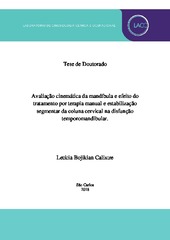| dc.contributor.author | Calixtre, Letícia Bojikian | |
| dc.date.accessioned | 2018-05-10T13:32:48Z | |
| dc.date.available | 2018-05-10T13:32:48Z | |
| dc.date.issued | 2018-02-15 | |
| dc.identifier.citation | CALIXTRE, Letícia Bojikian. Avaliação cinemática da mandíbula e efeito do tratamento por terapia manual e estabilização segmentar da coluna cervical na disfunção temporomandibular. 2018. Tese (Doutorado em Fisioterapia) – Universidade Federal de São Carlos, São Carlos, 2018. Disponível em: https://repositorio.ufscar.br/handle/ufscar/9947. | * |
| dc.identifier.uri | https://repositorio.ufscar.br/handle/ufscar/9947 | |
| dc.description.abstract | The central aims of this PhD thesis were: (1) to verify the reproducibility of kinematic variables during maximum mouth opening (MMO) and (2) to investigate the regional interdependency between the upper cervical spine and the orofacial region, using a randomized controlled trial (RCT) where was collected kinematic and clinical outcomes after a physiotherapeutic treatment for the neck in women with temporomandibular disorders (TMD). Therefore, 4 studies were developed. The First Study investigated the reliability of the kinematic analysis of the jaw movement in asymptomatic subjects. The results showed that the reproducibility of the measures depends on the data analysis and on the variables. Static measurements like jaw radius and width were the most reproducible ones. Furthermore, the interincisal distance during MMO and the angular movements of the jaw in sagittal plane presented the smallest errors and should be used in future studies. In general, the variables with low amplitude were less reproductible, with higher Standard Error of Measurement (SEM) and Minimum Detectable Change (MDC). Finally, the inter-rater comparisons presented larger limits of agreement and more frequent outliers. The Second, Third and Fourth studies were elaborated from one RCT that included 61 women with TMD, divided into two groups: Control Group (CG) and Intervention Group (IG). IG was submitted to 10 sessions of physiotherapy based on manual therapy applied on the upper cervical spine and stabilization exercises to the neck, for 5 weeks. The CG did not get any intervention for 5 weeks. Clinical and kinematic variables were collected on baseline and after 5 weeks by a blind rater. The analysis of the Second study aimed: (1) to determine the effectiveness of the protocol to reduce orofacial pain intensity on IG compared to CG, after and during 5 weeks (2) to verify the differences between the groups after 5 weeks on the following secondary variables: Pressure Pain Threshold (PPT) of the masticatory muscles, mandibular function and headache impact in women with TMD. The results showed significant decrease of orofacial pain intensity since 4 weeks of treatment in comparison to CG and in comparison to baseline. There were no significant differences on PPT and no clinically relevant differences on mandibular function. The Third study was based on a secondary analysis of the RCT in order to (1) provide the Minimum Clinical Important Difference (MCID) from the variables related to orofacial pain, headache impact, sensibility of the masticatory muscles, mandibular function and the performance of deep neck flexor muscles, according to an anchor method of analysis, using the Global Rating of Change Scale (GRCS); (2) verify which outcomes can predict the moderate or large response to the treatment. The analysis provided MCID values for variables related to maximum, minimum and current orofacial pain using Visual Analogue Scale (VAS), for the Mandibular Function Impairment Questionnaire (MFIQ), for the Headache Impact Test (HIT-6), for the PPT of the masticatory muscles, for the MMO measured with a caliper, and for the Craniocervical Flexion Test (CCFT). On the univariate regression analysis, among all the outcomes, the ones related to pain and the HIT-6 presented better capacity of discrimination between patients who largely or moderately got better from those who did not. On the multivariate regression analysis, the combination of minimum pain (or any other pain score) and HIT-6 presented the best capacity of discrimination between patients who largely or moderately improved from those who did not. Finally, the Fourth study focused on two clinical variables and several kinematic variables, with the following objectives: (1) verify the effects of the intervention on the behavior of kinematic variables related to range of motion and coordination of the head and jaw during MMO, speech and chewing in women with TMD; (2) verify the differences between the groups regarding the performance of the deep neck flexor muscles (according to the CCFT) and the perception of the patients regarding their global status of health (according to the GRCS) after the intervention/control. The results showed absence of significant effect of the intervention on the kinematic variable´s behaviour regarding range of motion and coordination between head and jaw during MMO, speech and chewing in women with TMD. On the other hand, the IG presented significant improvement on the GRCS, as well as on the CCFT. In general, this thesis enabled the kinematic evaluation of the jaw in order to investigate the normal or pathologic biomechanical patterns of the jaw, provided reference measures for the interpretation of clinical variables related to TMD, that can be used on the clinical settings and research fields, so future studies can continue to investigate this population. On top of that, this thesis cooperates for the evidence of regional interdependency between the upper cervical spine and the jaw, filling some of the knowledge gaps on the literature and suggesting ideas for future studies. | eng |
| dc.description.sponsorship | Coordenação de Aperfeiçoamento de Pessoal de Nível Superior (CAPES) | por |
| dc.description.sponsorship | Fundação de Amparo à Pesquisa do Estado de São Paulo (FAPESP) | por |
| dc.language.iso | por | por |
| dc.publisher | Universidade Federal de São Carlos | por |
| dc.rights.uri | Acesso aberto | por |
| dc.subject | Fisioterapia | por |
| dc.subject | Biomecânica | por |
| dc.subject | Reprodutibilidade dos testes | por |
| dc.subject | Disfunção temporomandibular | por |
| dc.subject | Diferença mínima detectável | por |
| dc.subject | Diferença mínima clinicamente importante | por |
| dc.subject | Movimento tridimensional | por |
| dc.subject | Physical therapy specialty | eng |
| dc.subject | Biomechanics | eng |
| dc.subject | Reproducibility of findings | eng |
| dc.subject | Temporomandibular joint disorders | eng |
| dc.subject | Musculoskeletal manipulations | eng |
| dc.subject | Neck | eng |
| dc.title | Avaliação cinemática da mandíbula e efeito do tratamento por terapia manual e estabilização segmentar da coluna cervical na disfunção temporomandibular | por |
| dc.type | Tese | por |
| dc.contributor.advisor1 | Oliveira, Ana Beatriz de | |
| dc.contributor.advisor1Lattes | http://lattes.cnpq.br/1049547759186556 | por |
| dc.contributor.advisor-co1 | Alburquerque-Sendín, Francisco | |
| dc.contributor.advisor-co1Lattes | http://lattes.cnpq.br/7551905278202959 | por |
| dc.description.resumo | Os objetivos centrais dessa tese de Doutorado foram: (1) verificar a reprodutibilidade de variáveis cinemáticas durante a máxima abertura da boca (MAB) e (2) investigar a interdependência regional entre a coluna cervical alta e a região orofacial por meio de um ensaio clínico randomizado controlado (RCT), a partir de variáveis cinemáticas e clínicas, após um protocolo de intervenção fisioterapêutica voltado para a coluna cervical, em mulheres com Disfunção temporomandibular (DTM). Para isso, foram desenvolvidos 4 estudos. O Estudo 1 avaliou a confiabilidade da análise cinemática dos movimentos da mandíbula em sujeitos assintomáticos. Os resultados indicaram que a reprodutibilidade das medidas depende da análise de dados e também das variáveis. Medidas estáticas, como o raio e a largura da mandíbula, foram as variáveis mais reprodutíveis. Além disso, a distância interincisal durante a MAB e os movimentos angulares da mandíbula no plano sagital apresentaram os menores erros e podem ser usados em futuros estudos. As variáveis com pouca amplitude foram, em geral, menos reprodutíveis, com maior Erro Padrão da Medida (EPM) e Diferença Mínima Detectável (DMD). Por fim, a comparação entre-avaliadores aprentou limites de concordância mais amplos e mostraram mais outliers. Os Estudos 2, 3 e 4 foram elaborados a partir de dados coletados em um RCT, que incluiu 61 mulheres com DTM, divididas em dois grupos: Grupo Controle (GC) e Grupo Intervenção (GI). O GI foi tratado com 10 sessões de um protocolo fisioterapêutico baseado em terapia manual para a coluna cervical alta e exercícios de estabilização segmentar para a coluna cervical, por 5 semanas. O GC não recebeu intervenção alguma por 5 semanas. Variáveis clínicas e cinemáticas foram coletadas antes e após o período de 5 semanas por um avaliador cego. A análise proposta no Estudo 2 teve como objetivo: (1) determinar se o protocolo de intervenção foi capaz de melhorar a intensidade da dor orofacial do GI, comparado ao GC; (2) verificar se, ao final de 5 semanas, houve diferença entre os grupos nas seguintes variáveis secundárias: Limiar de Dor à Pressão (LDP) dos músculos mastigatórios, função mandibular e impacto da cefaleia. Os resultados mostraram que o protocolo foi capaz de diminuir a dor orofacial e o impacto da cefaleia em mulheres com DTM. A dor melhorou significativamente a partir da quarta semana de intervenção, em comparação ao GC e à avaliação inicial. Não houve melhora no LDP da musculatura mastigatória e diferenças clinicamente irrelevantes foram encontradas na variável referente à função mandibular. No Estudo 3 foi realizada uma análise secundária do RCT a fim de (1) fornecer a Diferença Mínima Clinicamente Importante (DMCI) das variáveis referentes à dor orofacial, impacto da cefaleia, sensibilidade dos músculos mastigatórios, função mandibular e performance dos músculos flexores profundos cervicais a partir de um método baseado em ancoragem, utilizando a Global Rating of Change Scale (GRCS); (2) verificar quais desfechos podem predizer a melhora moderada ou intensa do quadro clínico de um paciente após o tratamento. O método de análise possibilitou o cálculo das DMCI para as variáveis de dor orofacial máxima, mínima e no momento da avaliação pela Escala Visual Analógica (EVA), para o Mandibular Function Impairment Questionnaire (MFIQ), para o Headache Impact Test (HIT-6), para o LDP dos músculos mastigatórios, para a MAB e para o Teste de Flexão Craniocervical (TFCC). As escalas de dor e o HIT-6 isoladamente apresentaram moderada capacidade de predizer a melhora do quadro clínico. A combinação de dor mínima (ou qualquer outra escala de dor) com o HIT-6 apresentou melhor capacidade de discriminar sujeitos que melhoraram moderadamente e intensamente dos que não melhoraram. Por fim, o Estudo 4 foi focado em duas variáveis clínicas que se referiam ao movimento e nas variáveis cinemáticas, com os seguintes objetivos: (1) observar os efeitos da intervenção no comportamento de variáveis cinemáticas relacionadas à amplitude e coordenação dos movimentos de cabeça e mandíbula durante a MAB, a fala e a mastigação em mulheres com DTM; (2) observar a variação da performance dos músculos flexores profundos do pescoço e a percepção das participantes em relação à evolução do quadro clínico após a intervenção. Nesse recorte, verificou-se a ausência de efeitos da intervenção proposta no comportamento de variáveis cinemáticas relacionadas à amplitude e coordenação dos movimentos de cabeça e mandíbula durante a MAB, a fala e a mastigação em mulheres com DTM. Por outro lado, os sujeitos tratados apresentaram melhora significativa do seu quadro clínico (a partir da GRCS), bem como da performance dos músculos flexores profundos da coluna cervical. De forma geral, essa tese viabiliza o uso da avaliação cinemática da mandíbula, que será útil na investigação do padrão biomecânico normal e alterado da mandíbula, fornece medidas de referência para interpretação de variaveis relacionadas à DTM e utilizadas tanto na prática clínica como no ambiente de pesquisa para que futuros estudos continuem investigando o tema, e coopera para a evidência da interdependência regional entre a coluna cervical e a mandíbula, completando algumas lacunas do conhecimento e sugerindo ideas para futuros estudos. | por |
| dc.publisher.initials | UFSCar | por |
| dc.publisher.program | Programa de Pós-Graduação em Fisioterapia - PPGFt | por |
| dc.subject.cnpq | CIENCIAS DA SAUDE::FISIOTERAPIA E TERAPIA OCUPACIONAL | por |
| dc.description.sponsorshipId | FAPESP: 2014/05276-7 | por |
| dc.ufscar.embargo | Online | por |
| dc.publisher.address | Câmpus São Carlos | por |
| dc.contributor.authorlattes | http://lattes.cnpq.br/8265560955064959 | por |

